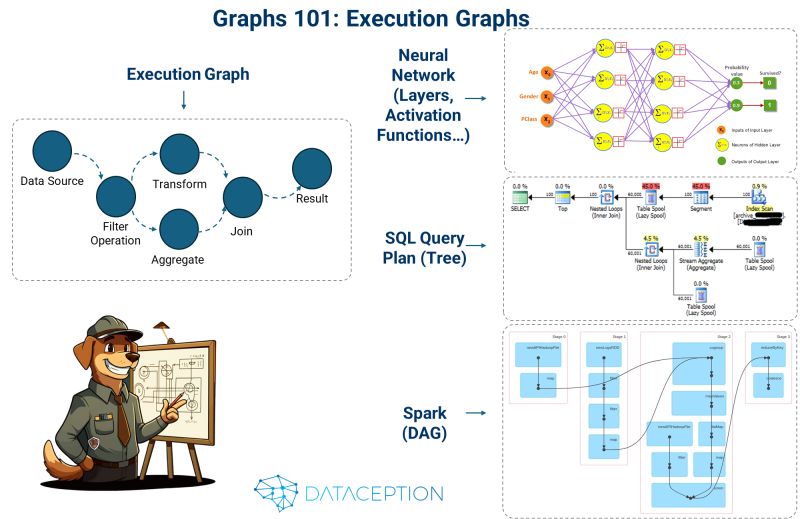In our journey through graph structures, we’ve covered data graphs, which define relationships between entities. Now, we shift gears to execution graphs—the dynamic frameworks that power computational processes.
While data graphs help us discover relationships, execution graphs help us execute computations efficiently. Whether it’s database queries, machine learning pipelines, or large-scale data processing, execution graphs provide the structure needed to orchestrate and optimize complex workflows.
What Are Execution Graphs?
An execution graph models a sequence of computational steps, where:
🔹 Nodes represent operations (e.g., mathematical functions, database joins, or ML model layers).
🔹 Edges define dependencies—an operation can only execute once its required inputs are ready.
This makes execution graphs flow-oriented, ensuring processes execute efficiently, in order, and with resource optimization.
Execution Graphs vs. Data Graphs
The key distinction:
🔹 Data graphs answer: "What entities are connected?"
🔹 Execution graphs answer: "What operations should be performed, and in what order?"
Traversal in a Data Graph explores relationships, while traversal in an Execution Graph triggers computations.
Real-World Examples of Execution Graphs
1️⃣ SQL Query Execution Graphs 🗄️
When a SQL query is executed, databases internally convert it into an execution graph.
Take this query:
sqlCopyEditSELECT SUM(order_total)
FROM orders
JOIN customers
ON orders.customer_id = customers.id
WHERE customers.status = 'active';
Behind the scenes, the database:
1️⃣ Converts the query into an execution graph (scan, filter, join, aggregate).
2️⃣ Optimizes the graph by reordering operations for efficiency.
3️⃣ Executes each node in sequence, passing results through the graph.
4️⃣ Returns the final result.
The graph structure helps databases maximize speed by optimizing joins, parallelizing operations, and caching intermediate results.
2️⃣ Neural Networks and Computational Graphs 🧠
Machine learning frameworks like TensorFlow and PyTorch rely on execution graphs to train and run deep learning models efficiently.
🔹 Nodes represent tensor operations (e.g., matrix multiplication, convolution, activation functions).
🔹 Edges define how tensors flow between operations.
Training a deep learning model involves two passes through the execution graph:✔️ Forward Pass: Data moves forward, generating predictions.✔️ Backward Pass: Gradients flow backward, updating weights via automatic differentiation.
This execution graph ensures optimal GPU utilization, parallel computation, and efficient training of AI models.
3️⃣ DAGs in Data Processing Pipelines 🔥
A common form of execution graph is a Directed Acyclic Graph (DAG), used in ETL (Extract, Transform, Load) and big data frameworks like Apache Spark.
🔹 Nodes represent data transformations (e.g., filtering, mapping, aggregating).
🔹 Edges define dependencies—ensuring that data transformations execute in the correct order.
For example, in Spark:
1️⃣ Raw data is ingested into a DAG.
2️⃣ The DAG is optimized, removing redundant steps and maximizing parallel execution.
3️⃣ Each transformation is executed, distributing work across a cluster.
This structured execution enables fault tolerance, parallelization, and scalable data processing across massive datasets.
Why Execution Graphs Matter
Execution graphs power modern computation by:
✅ Optimizing workflows—choosing the most efficient execution path.
✅ Parallelizing operations—distributing work for faster processing.
✅ Enabling fault tolerance—recovering from failures in distributed systems.
✅ Reducing resource waste—ensuring computations execute only when needed.
Execution graphs are the reason we can process massive datasets, train deep AI models, and execute complex queries with lightning speed.

Looking Ahead: Hybrid Graphs – Merging Data and Execution
Next, we’ll explore hybrid graphs, which combine data and execution graphs—allowing AI-driven systems to store knowledge and act on it dynamically.
Stay tuned! 🚀

